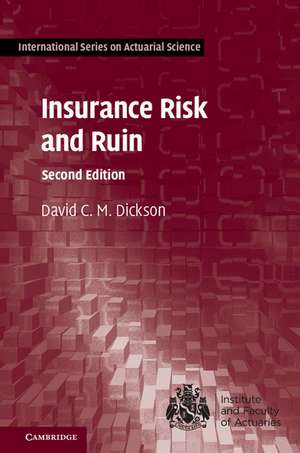Insurance Risk and Ruin: International Series on Actuarial Science
Autor David C. M. Dicksonen Limba Engleză Hardback – 26 oct 2016
Din seria International Series on Actuarial Science
- 8%
 Preț: 522.63 lei
Preț: 522.63 lei - 11%
 Preț: 485.19 lei
Preț: 485.19 lei - 8%
 Preț: 572.42 lei
Preț: 572.42 lei - 8%
 Preț: 431.26 lei
Preț: 431.26 lei - 14%
 Preț: 724.77 lei
Preț: 724.77 lei - 14%
 Preț: 901.43 lei
Preț: 901.43 lei - 11%
 Preț: 487.17 lei
Preț: 487.17 lei - 14%
 Preț: 678.30 lei
Preț: 678.30 lei -
 Preț: 475.97 lei
Preț: 475.97 lei - 11%
 Preț: 458.42 lei
Preț: 458.42 lei - 11%
 Preț: 543.38 lei
Preț: 543.38 lei - 11%
 Preț: 652.53 lei
Preț: 652.53 lei - 14%
 Preț: 777.40 lei
Preț: 777.40 lei -
 Preț: 352.50 lei
Preț: 352.50 lei - 11%
 Preț: 540.91 lei
Preț: 540.91 lei
Preț: 357.63 lei
Preț vechi: 448.85 lei
-20% Nou
68.44€ • 74.32$ • 57.49£
Carte indisponibilă temporar
Specificații
ISBN-10: 110715460X
Pagini: 304
Ilustrații: 30 b/w illus. 18 tables
Dimensiuni: 157 x 235 x 18 mm
Greutate: 0.62 kg
Ediția:2Revizuită
Editura: Cambridge University Press
Colecția Cambridge University Press
Seria International Series on Actuarial Science
Locul publicării:New York, United States
Cuprins
Preface; 1. Probability distributions and insurance applications; 2. Utility theory; 3. Principles of premium calculation; 4. The collective risk model; 5. The individual risk model; 6. Introduction to ruin theory; 7. Classical ruin theory; 8. Advanced ruin theory; 9. Reinsurance; Appendix; Solutions to exercises; References; Index.
Descriere
The focus of this book is on the two major areas of risk theory: aggregate claims distributions and ruin theory. For aggregate claims distributions, detailed descriptions are given of recursive techniques that can be used in the individual and collective risk models. For the collective model, the book discusses different classes of counting distribution, and presents recursion schemes for probability functions and moments. For the individual model, the book illustrates the three most commonly applied techniques. Beyond the classical topics in ruin theory, this new edition features an expanded section covering time of ruin problems, Gerber–Shiu functions, and the application of De Vylder approximations. Suitable for a first course in insurance risk theory and extensively classroom tested, the book is accessible to readers with a solid understanding of basic probability. Numerous worked examples are included and each chapter concludes with exercises for which complete solutions are provided.
